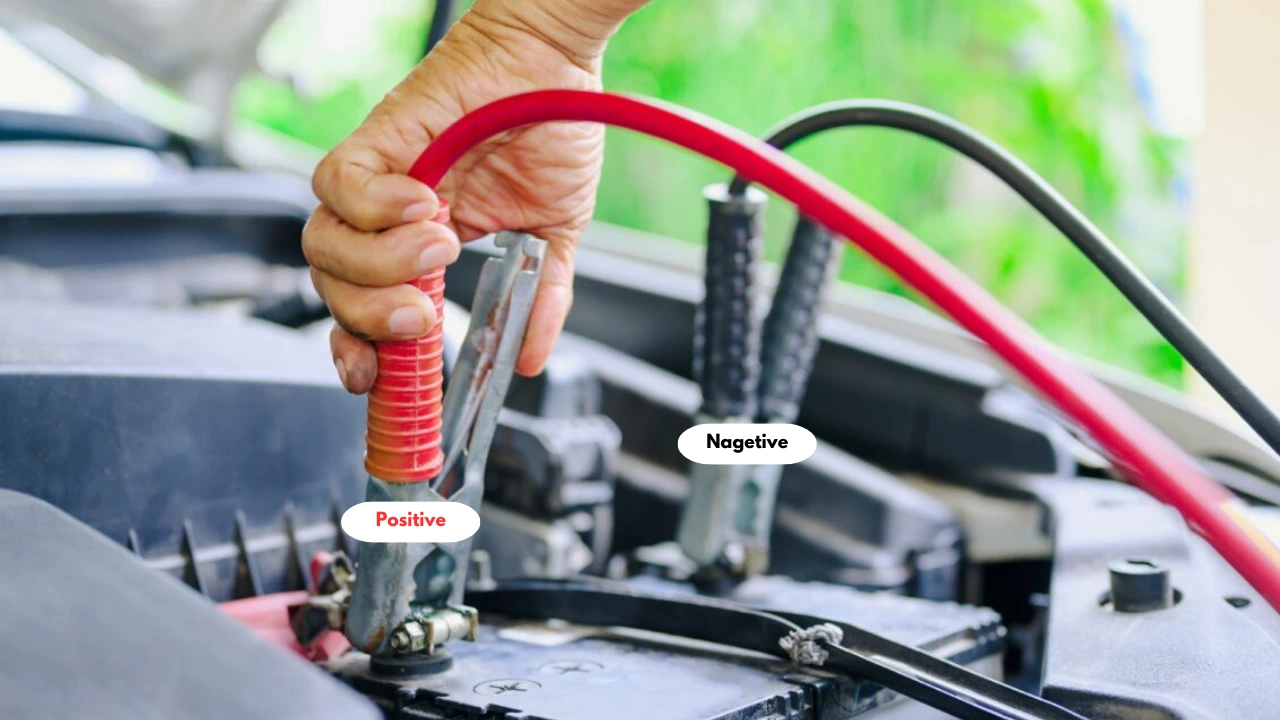Jumper cables are thick wires that can be used to start a car when its battery does not have enough power. Jumper cables connect the battery to the battery of another car that is working correctly.
Jumper cables, booster cables, or jumper leads (all three terms describe the same product), let you get a jump start of your dead car battery. The cables connect the battery of a running car to the battery of your dead (won’t-start) car.
The red jumper cable is positive and should be connected to the positive battery terminals. The remaining black cable is the negative cable and should be connected to the negative battery terminals.
Jumper Cables Positive and Negative

Your jumper cables have 4 sets of clips or alligator clips. Red is positive and black is negative.
The red wire almost always means a positive conductor carrying current from the source when talking about the DC power cable color code. The return wire or negative cable is usually black. This is the widely accepted cable code convention used worldwide.
So, is the positive wire red? Yes. The red jumper cable is connected to the positive battery terminal, and the black one is connected to the negative terminal. Reversing the wires can cause them to melt due to overheating.
If it is a black and yellow cable then: Yellow is positive and black is negative.
Always connect your jumper cables appropriately, as we shall see later in this post.
Which Jumper Cable Goes on First?
Once the two vehicles are in place, turn off both and open the hoods. Attach the red jumper cables first. Start by clamping one red cable to the positive side of the battery that won’t start. Then attach the other red clamp to the positive side of the working battery.
Next, clamp one black cable to the negative side of the working battery. When you’re ready to attach the other black clamp, don’t connect it to the dead battery. Instead, find a metal component in your vehicle’s engine block where you can attach it safely.
Once the two vehicles are in place, turn off both and open the hoods.
- Attach one red jumper cable clamp to the positive terminal on the dead battery.
- Attach the other end of the same cable, the second red jumper cable clamp, to the positive terminal on the working (live) car battery.
- Attach one black jumper cable clamp to the negative terminal of the working (live) car’s battery.
- Attach the other end of that cable, the second black jumper cable clamp, to an unpainted piece of stationary metal on the car with the dead battery.
- Do not attach this clamp to the negative terminal on the dead car’s battery.
Related Posts:
- Do Jumper Cables Go Bad?
- Do I Need to Replace the Battery After Jump Start?
- Can You Jump a Car in the Rain? How to Do It Safely
What Happens If You Connect The Jumper Cables Incorrectly?
Hooking the jumper cables up backward can create disastrous results. Possible outcomes include irreparable damage to the battery, fried electronics, and even serious personal injury.
Exactly what will happen when jumper cables are incorrectly connected depends on several factors, including the vehicle, the battery, the quality of your cables, and sheer luck.
Here’s what can happen if you accidentally hook the cables up wrong when jumping a car:
You might cause personal injury and damage to your car if you accidentally hook your jumper cables up wrong.
Blown fuses/fusible links.
Fuses (and/or fusible links) act as circuit protection devices between the battery and the vehicle’s electrical system. Connecting the jumper cables backward will often result in one or more blown fuses. The affected circuit will not function correctly until the blown fuse is replaced.
Damaged battery
Reversing the battery cables creates a surge of electrical current that can easily damage the battery.
Damaged jumper cables
When you reverse the polarity of the jumper cables, you create a drastic increase in the amount of electrical current that runs through them. As a result, the cables may melt or even catch fire.
Fried electrical components and wiring
In a perfect world, your car’s fuses would protect all the sensitive electronics from the surge in electrical energy created by reversed battery cables.
But it’s not a perfect world, and all too often, the alternator and other electrical components (i.e., wiring, modules, etc.) can become damaged when the cables get swapped.
Personal injury
Don’t attach the negative cable to the negative terminal of the weak battery when jumping a car battery! This common mistake could ignite hydrogen gas directly over the battery. Battery explosions can cause serious injury.
Even if you’ve gotten away with it before, use a metallic engine part instead when jumping a car.
When the jumper cables are hooked up to a battery, touching the cable ends together can create sparks.